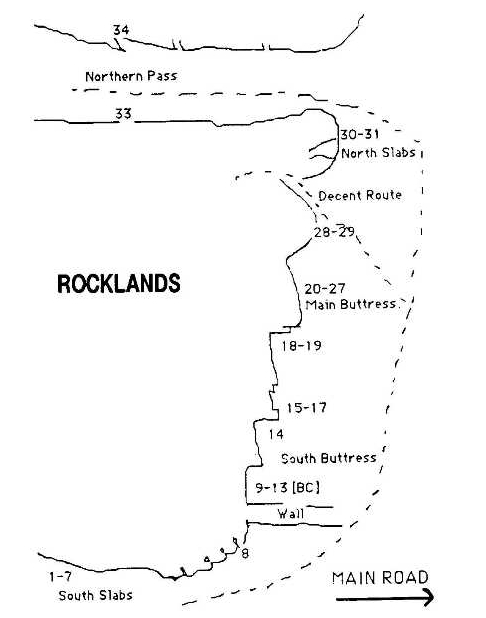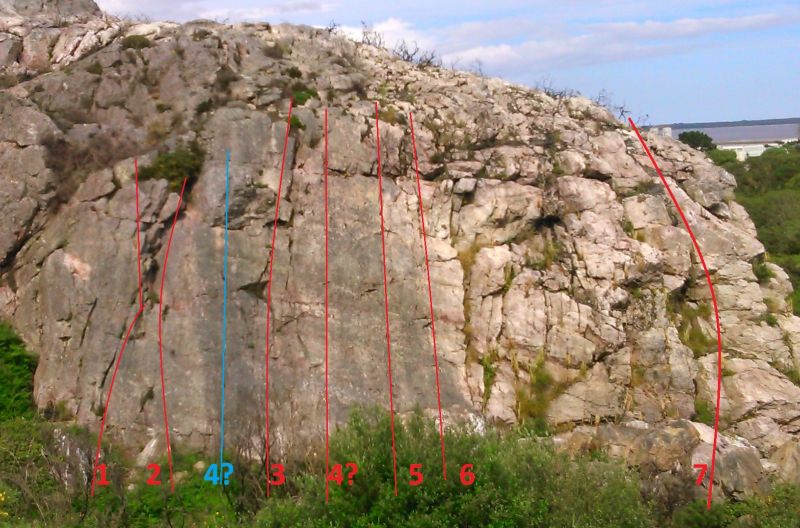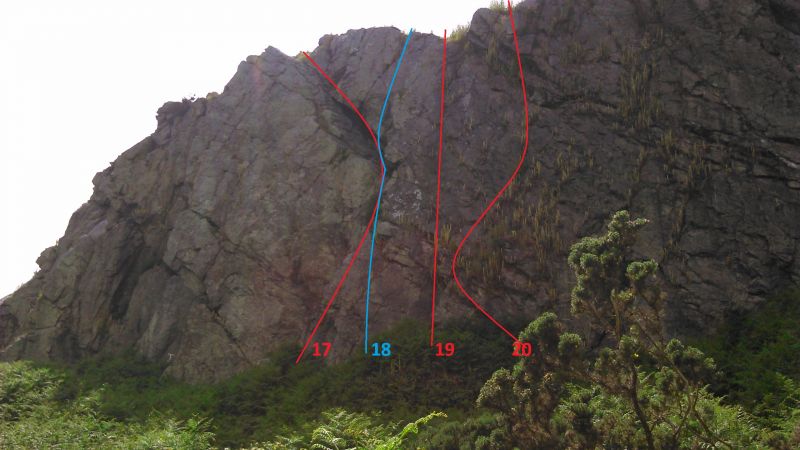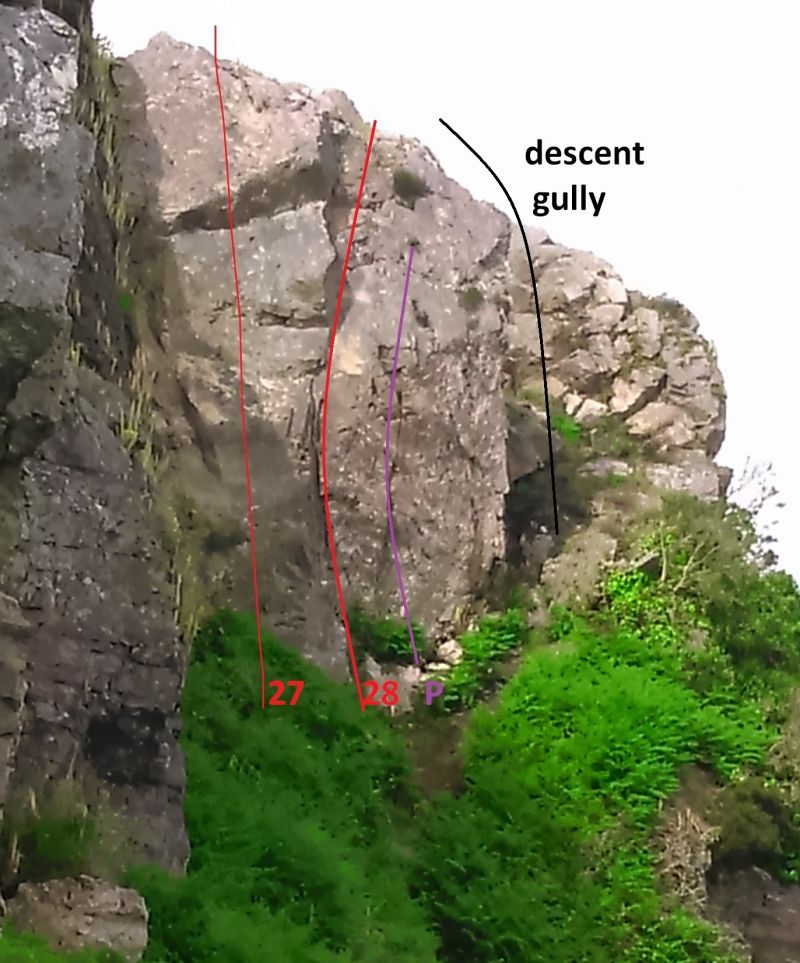Difference between revisions of "Rocklands"
m |
|||
| Line 32: | Line 32: | ||
== South Slabs == | == South Slabs == | ||
| − | [[File:Southslabs.JPG| | + | [[File:Southslabs.JPG|800px|Southslabs.JPG]] |
These are located on the extreme L of the crag, to the L of a wall. Descent is to the L of the slabs.<br/>'''1. Plum Pud.''' 30ft Diff.<br/>This route takes the shallow groove on the L of the slab, at an arete. Climb short groove. Step L onto ledge and follow easy line on L to top.<br/>J. Leonard, J. Flynn. 27/12/1977 | These are located on the extreme L of the crag, to the L of a wall. Descent is to the L of the slabs.<br/>'''1. Plum Pud.''' 30ft Diff.<br/>This route takes the shallow groove on the L of the slab, at an arete. Climb short groove. Step L onto ledge and follow easy line on L to top.<br/>J. Leonard, J. Flynn. 27/12/1977 | ||
| Line 50: | Line 50: | ||
== South Buttress. == | == South Buttress. == | ||
| − | [[File:Mainface1.JPG| | + | [[File:Mainface1.JPG|800px|upright|Mainface1.JPG]] [[File:Mainface2.JPG|800px|Mainface2.JPG]] |
'''This section stretches from just R of the wall to a wide, vegetated crack at its R end.''' | '''This section stretches from just R of the wall to a wide, vegetated crack at its R end.''' | ||
| Line 76: | Line 76: | ||
== Main Buttress. == | == Main Buttress. == | ||
| − | [[File:Mainface4.JPG| | + | [[File:Mainface4.JPG|800px|Mainface4.JPG]] [[File:Mainface5.JPG|none|Mainface5.JPG]] |
'''Lying to the R of South Buttress, this is the highest part of the crag and is characterised by big, tilting walls.''' | '''Lying to the R of South Buttress, this is the highest part of the crag and is characterised by big, tilting walls.''' | ||
| Line 100: | Line 100: | ||
A small section, it lies at R angles to the Main Buttress, just R of Troubadour, and is flanked at each end by a gully. Descent is via the R-hand gully. | A small section, it lies at R angles to the Main Buttress, just R of Troubadour, and is flanked at each end by a gully. Descent is via the R-hand gully. | ||
| − | [[File:Mainface3.JPG| | + | [[File:Mainface3.JPG|800px|Mainface3.JPG]] |
'''27. Pegasus.''' 40ft. Severe.<br/>Start 10ft. R of the big vegetated groove.<br/>Climb straight up to a small stance beneath the overhang (runner). Move up onto the slab above the overhang and climb this to the top.<br/>J. Hastings, J. Flanagan. Feb. 1978. | '''27. Pegasus.''' 40ft. Severe.<br/>Start 10ft. R of the big vegetated groove.<br/>Climb straight up to a small stance beneath the overhang (runner). Move up onto the slab above the overhang and climb this to the top.<br/>J. Hastings, J. Flanagan. Feb. 1978. | ||
| Line 119: | Line 119: | ||
'''Finally, to the R again we have '''The Northern Pass'''which is flanked by rock on both sides. The pass contains some large blocks and is about 70ft. wide.''' | '''Finally, to the R again we have '''The Northern Pass'''which is flanked by rock on both sides. The pass contains some large blocks and is about 70ft. wide.''' | ||
| − | |||
| − | |||
'''32. Most Secret.''' 30ft. Diff.<br/>Start at the lowest point of the overhang, beside a small block, about halfway along the pass, at the end of the slab.<br/>Stand on block, gain slab above and climb straight to top.<br/>P. Coakley. 2/4/1978. | '''32. Most Secret.''' 30ft. Diff.<br/>Start at the lowest point of the overhang, beside a small block, about halfway along the pass, at the end of the slab.<br/>Stand on block, gain slab above and climb straight to top.<br/>P. Coakley. 2/4/1978. | ||
Revision as of 14:06, 28 March 2021
Discovered by the indefatigable Stephen Young, only minutes after disembarking from the Rosslare ferry on his first visit to Ireland, this crag lay undisturbed until the newly-formed and now defunct Raparee Climbing Club, prompted by Jim Leonard, decided to develop it in the mid-to-late seventies.
Although not a large crag, its location, in the sunny southeast, lying just in from the coast and away from the hills, means it may often be in condition when the mountain crags are out of the loop. This makes it a valuable asset, not just to local climbers, but to Dublin based trad climbers too, as the roads to Rosslare have been greatly improved over recent years. When I last climbed here, back in the eighties, some of the routes had become a little vegetated, but this is no longer the case. Recently Wexford Hillwalking club have started weekly Summer Meets at the crag, and through their hard work some of the more overgrown routes have emerged. There may be opportunities for further routes here, particularly in the higher grades.
Approach and Access. Although access was an issue the the past. Access is now available either from the Mulgannon Road, the lane at the back of Tesco's or from the Kerlogue road; described below. In 2014 the fields around the crag were planed with eucalptus trees, this doesn't seem to have affected access.
Nowadays, to get to the crag from Dublin, follow the N11 to the Gorey south exit follow the R741 into Wexford town turning left at the bridge. There are three modes of access;
From the Mulgannon road which has some parking and tends to be less muddy. From the lane at the back of Tescos which is closer to public transport but also has parking. From Kerlogue Road more hacking through bushes and less driving through town.
FOR Approach from the Mulgannon Road; Continue along the quays turning right at the first set of traffic lights just before the Talbot hotel. At the traffic lights near Tesco go left, then right keep going straight through the roundabout and up the hill until there's an electric station on your right (note this is NOT the eircom tower by the roundabout) take the next left down a country lane. Park. climb the gate near the ?wall/barn? and follow the map below. 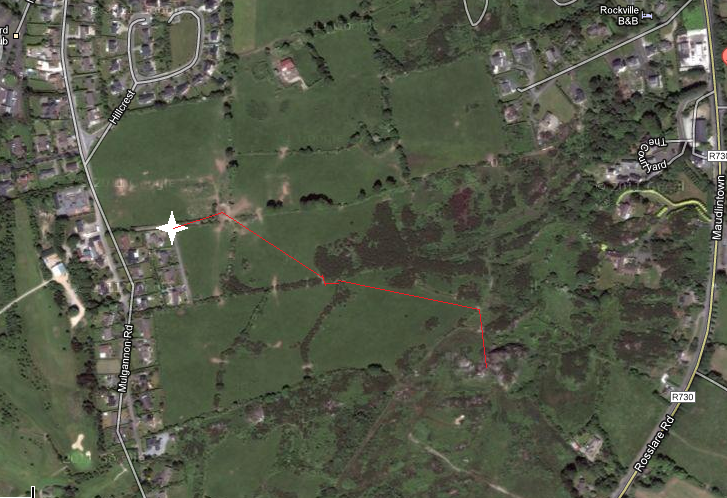
FOR Approach from the Tesco's Lane; Continue along the quays turning right at the first set of traffic lights just before the Talbot hotel. At the traffic lights near Tesco go left, then fork right. Pull in on the left in front of the bug gates. walk up the lane. once you are in the park head in the rough direction of the crag and try not to get lost in the gorse maze.
FOR Approach from the Kerlogue Road Follow along the quays and out of Wexford towards Rosslare. A grotto is seen on the right with the crag is a short distance behind, and is easily recognizable from the road. Drive till there is a field on your right, park near the gate, cross the field and find a path to the base of the crag.
The following information is taken directly from the Raparee guide book to Rocklands, published about 1980 and edited by P. Coakley
The rock is impure quartzite, many of the routes tackle bulges or overhangs, and friends may be useful for protection.
The climbs are described from L to R when facing the rock.
South Slabs
These are located on the extreme L of the crag, to the L of a wall. Descent is to the L of the slabs.
1. Plum Pud. 30ft Diff.
This route takes the shallow groove on the L of the slab, at an arete. Climb short groove. Step L onto ledge and follow easy line on L to top.
J. Leonard, J. Flynn. 27/12/1977
2. Fickle Fingers. 35ft. Severe
This route starts about 5ft R of Plum Pud.
Gain a high foothold on slab using strenuous finger pulls on R and L. Move up on good holds to steeper section and move L to corner and up edge to top.
J. Leonard, P. O'Connor. 22/1/1978
Variant No. 1. Gain small knob on slab from L. Move straight up from knob to edge, without deviating R or L (strenuous).
Variant No. 2. Start 3ft L of Fickle Fingers. Move up to ledge then up to edge.
3. Stickleback Slab. 35ft. Severe.
This route takes a line halfway along the slab.
Climb obvious line of weakness to a niche. Move R using crack for foothold. Continue up, trending L to top.
J. Leonard. June 1974.
5. Devil's Pancake. 35ft. VS4c
Satrt 4 ft. R of Stickleback Slab.
Climb slab on small, but good, holds to bulge (runner). Continue over bulge on delicate holds (technical).
T. Irving, J. Flanagan, J. Leonard 29/1/1978.
5. Porcupine 40ft. VS4c
This route takes a line from a point about 8 ft. R of Stickleback, straight up to a large letterbox at about 25ft., and from there via a thin crack to the top.
Start directly below the letterbox. Climb slab on small holds to bulge (runner).Gain letterbox by one awkward move, step up and slightly R into crack. Climb this to top.
J. Hastings, M. Boushell. 1/4/1978.
6. Little Snip. 35ft. HS.
This route takes a line up the slab on the R of the slabs beside ivy.
Move up on finger pulls and footholds to the bulge. A difficult move leads to a ledge with good holds. Continue to top.
J. Leonard, P. O'Connor. 29/1/1978
7. Local's Way. 30 ft. Mod.
Start halfway along the path to South Slabs and just L of the wall. Climb on good holds to ledge, move slightly R and continue straight to top.
South Buttress.
This section stretches from just R of the wall to a wide, vegetated crack at its R end.
8. Creepy Crawl. 40ft. H.S.
Start between C.O.T.L.B. and Black Swan. Climb centre of wall to good ledge. Move up crack to sloping ledge and continue L under the overhang, to exit onto arete. Easily to top.
P. Daly, P. Coakley. 23/7/1978.
9. Charge of the Light Brigrade. 45ft. Diff. Start 10 ft. L of The Spider and just L of the grooved nose.
Move up on L of nose and up to ledge, continuing up crack to top.
P. Coakley, P. Daly. 23/7/1978.
10. The Black Swan. 40ft. V. Diff.
Start by the wall at the L end of the buttress.
Climb onto small ledge then move R to bulge and onto slab. Move L around the nose and up slabs to top.
P. O'Connor. 28/5/1978
11. The Spider. 55ft. VS.
This route takes a R-trending crack which starts 8ft. above the ground.
Start about 8ft L of Nectaris. Climb onto block and move up crack with increasing difficulty to small ramp below nose. Continue up L side of nose to top.
P. Wynne, P. Coakley 2/4/1978. (one point of aid)
First free ascent P. Coakley.
12. Nectaris 55ft. HVS.
Start below big flake 3ft L of Bushwhacker.
Climb to top of Flake. Traverse L and mantle onto block. Traverse diagonally R to top.
T. Irving 29/1/1978.
13. Bushwhacker 55ft. HS.
This route takes the wide crack at the back of big vee groove.
Climb the wide crack to narrow ledge. Continue up the outside of the crack, using good footholds on either side. Gain a spike jug. Move around bush stump to top.
J. Leonard, P. O'Connor. 2/2/1978.
14. Smash and Grab. 55ft. VS.
This route takes a line up small thin crack about 4 ft. R of Bushwhacker.
Climb up middle of slab to small ledge on R. Step up L onto nose, gain the crack and continue straight to top on good holds.
P. Wynne, P. Coakley. 16/4/1978.
15. Garnet. 60ft. HVS.
Start around the corner from Bushwhacker, at base of groove.
Climb easily to the crack.Traverse L under overhang to gain stance on ledge. Traverse diagonally R to horizontal crack. Straight up front corner for 6 ft. (runner).Traverse back around the corner and continue to top. (Poor protection)
T. Irving, T. McGurk. 5/2/1978.
16. Letus. 60 ft. HVS.
Start about 10 ft. L of vegetated crack.
Climb for 15 ft. to crack. Traverse for nose. Climb edge to top. Protection poor.
T. Irving. 6/2/1978.
17. Chilli Con Corner. 60ft. V. Diff.
This route takes the big open crack.
Climb the obvious vegetated crack crack to a chimney. Move L up along ramp taking easiest line to top.
Belay well back.
J. Leonard, P. O'Connor. 14.1.1978.
Main Buttress.
Lying to the R of South Buttress, this is the highest part of the crag and is characterised by big, tilting walls.
18. Chimney Sweep. 55ft. S.
Start 8 ft. R of Chilli Con Corner, on the nose.
Climb up to ledge and step around into chimney. Move up chimney and follow steep groove to top. Belay well back.
J. Leonard, P. O'Connor, S. Young. 28/5/1978.
19. Burned Fingers. 55ft. VS 4b.
Start about 12ft. R of Chilli Con Corner, Below the first of two grooves. Climb up groove to good ledge. Move L for 2ft. (runner)then diagonally R to a small ledge at base of groove (crux). Continue more easily to top. Belay well back. Protection poor.
P. Coakley, J. Leonard. 28/5/1978
20. Scorpion. 60ft. HVS4c
Start about 14ft. R of Chilli Con Cornerat the second of two grooves.
Move up dirty groove to small grass ledge, continue up a few feet then go diagonally R to the lowest point of the overlap (delicate, runner). Step around overlap onto narrow ledge. Continue straight to top on good holds (strenuous). Belay well back. Protection poor.
P. Coakley, B. Walker. 23/4/1978.
21. Cygnus. 55ft. VS
Start about 30ft R of Chilli Con Corner.
Ascend L-hand corner of slab for about 12ft. (crux). Traverse L for 4ft. to large jug, straight up wall on good holds. Traverse R below block then R for top. Protection poor.
T. Irving, J. Flanagan. 6/7/1978.
22. Reunion. 70ft. VS. This route takes a traversing line at the R end of the buttress.
Start about 5ft. L of the big vegetated groove at lowest point of crack. Climb diagonally L along crack to ledge near top of wall (as for Scorpion). Step down and around L to smaller ledge (runner). Finish up groove above. Belay well back. Protection poor.
T. Irving, P. Coakley. 28/5/1978.
23. Maiden's Ladder. 55ft. HS.
Start as for reunion.
Climb L-ward leading ramp to a stance. Continue straight up on small sloping holds. Belay well back. Protection poor.
D. Kenna, C. McGrath. April, 1978
24. Jack in the Green. 70ft. VS4c.
Start 5ft. L of vegetated groove.
Gain the base of obvious diagonal crack. Climb this to a bulge and mantelshelf over this to top (crux).
B. Walker, T.Irving. 28/5/1978.
25. Ivy Direct. 60ft. HVS.
Start at base of vegetated groove (ivy).
Climb wall to small stance, continue to large ledge on good holds (overhanging). Climb 6ft. wall to top. Belay well back.
T. Irving, B. Walker. 28/4/1978
26. Troubadour. 65ft. HS.
Start as for Ivy Direct.
Climb with some delicate moves to gain the base of the corner. Bridge up the cornerto the ledge. Finish directly up wall. Belay well back.
B. Walker, T. Irving. 28/4/1978.
North Slabs
A small section, it lies at R angles to the Main Buttress, just R of Troubadour, and is flanked at each end by a gully. Descent is via the R-hand gully.
27. Pegasus. 40ft. Severe.
Start 10ft. R of the big vegetated groove.
Climb straight up to a small stance beneath the overhang (runner). Move up onto the slab above the overhang and climb this to the top.
J. Hastings, J. Flanagan. Feb. 1978.
28. Nth. Slabs Groove. 35ft. V. Diff.
North Buttress
Lying to the R of the descent gully mentioned above, it has a wide ledge and some blocks at its base.
29. Unshaven Texture. 45ft. E2 6a
Start under the obvious overhanging lip to the left of the face. Begin straight up the face to the lip
with difficulty and continue out left to good RP.
T. McGrath ??/07/2013
30. Left Hand Crack. 45ft. VS 4c
Start by two blocks with two cracks in the wall beside them.
Climb L-hand crack to ledge. Move R following easy line to top. Protection poor.
T. Irving. 5/2/1978.
31. Route 30. 45ft. HS.
Start between the two cracks.
Move up wall to ledge and continue up beside bush to top.
P. Wynne, A. Irving. Aug. 1978.
32. Right Hand Crack. 45ft. Severe.
Start just R of L-hand Crack.
Climb obvious crack to ledge. Move L to cornerbelow bush. Climb the corner past thebushto another ledge, then up wall to top.
J. Leonard, P. O'Connor, B. Walker. 23/4/1978.
Finally, to the R again we have The Northern Passwhich is flanked by rock on both sides. The pass contains some large blocks and is about 70ft. wide.
32. Most Secret. 30ft. Diff.
Start at the lowest point of the overhang, beside a small block, about halfway along the pass, at the end of the slab.
Stand on block, gain slab above and climb straight to top.
P. Coakley. 2/4/1978.
33. Come on 30ft. S as above stand on the block, climb the crack then onto the slabby wall climb to the top.
33.b variant 30ft. HS as above stand on the block, climb the crack then cross over onto the wall to your left climb to the top. H. Wallace, S. Conwell. 13/8/2011
34. The 20ft. Problem. H.V.Stupid.
Across from Most Secret there is a small outcrop with 3 wide cracks. This route takes the third of these, in the L-shaped corner. Doubtful rock on L-hand side.
T. Irving, P. Coakley. 28/5/1978.
